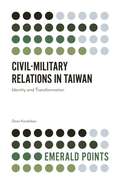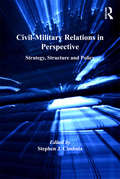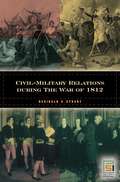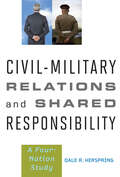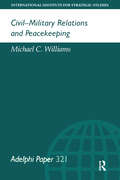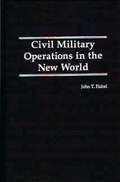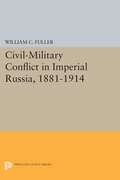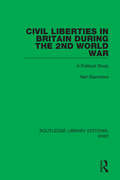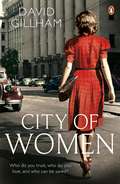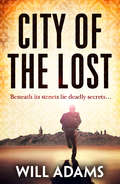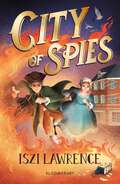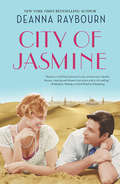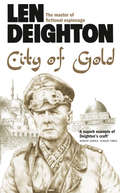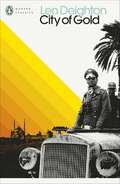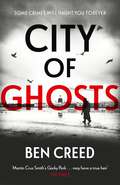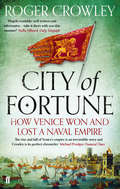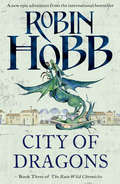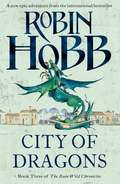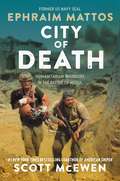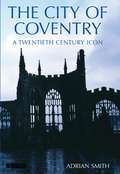- Table View
- List View
Civil-Military Relations in Taiwan: Identity and Transformation (Emerald Points)
by Dean KaralekasThe armed forces of the Republic of China (ROC) on Taiwan are in dire need of reform to address a plethora of problems including inadequate training, low morale, poor public perception, and low recruitment numbers. This book uses the postmodern military model to measure how public perception of the military is influenced by self-identification in Taiwan, and it shows that the public has little confidence or trust in their military, even as they remain acutely aware of the threat posed by an increasingly belligerent China and its ever-growing People's Liberation Army. While there has been much analysis as to what strategies and weapons systems should be adopted by ROC defense planners, relatively little has been written on how to create a more relevant military within Taiwan society. Ultimately, this book addresses these matters and provides policymakers within the ROC government and military, as well as researchers of Asia Pacific security, with an understanding of the current relationship between military and society, to assist in the creation of a more accountable military.
Civil-Military Relations in Taiwan: Identity and Transformation (Emerald Points)
by Dean KaralekasThe armed forces of the Republic of China (ROC) on Taiwan are in dire need of reform to address a plethora of problems including inadequate training, low morale, poor public perception, and low recruitment numbers. This book uses the postmodern military model to measure how public perception of the military is influenced by self-identification in Taiwan, and it shows that the public has little confidence or trust in their military, even as they remain acutely aware of the threat posed by an increasingly belligerent China and its ever-growing People's Liberation Army. While there has been much analysis as to what strategies and weapons systems should be adopted by ROC defense planners, relatively little has been written on how to create a more relevant military within Taiwan society. Ultimately, this book addresses these matters and provides policymakers within the ROC government and military, as well as researchers of Asia Pacific security, with an understanding of the current relationship between military and society, to assist in the creation of a more accountable military.
Civil-Military Relations in Perspective: Strategy, Structure and Policy
by Stephen J. CimbalaThe topic of civil-military relations has high significance for academics, for policy makers, for military commanders, and for serious students of public policy in democratic and other societies. The post-Cold War and post-9-11 worlds have thrown up traditional as well as new challenges to the effective management of armed forces and defense establishments. Further, the present century has seen a rising arc in the use of armed violence on the part of non-state actors, including terrorists, to considerable political effect. Civil-military relations in the United States, and their implications for US and allied security policies, is the focus of most discussions in this volume, but other contributions emphasize the comparative and cross-national dimensions of the relationship between the use or threat of force and public policy. Authors contributing to this study examine a wide range of issues, including: the contrast between theory and practice in civil-military relations; the role perceptions of military professionals across generations; the character of civil-military relations in authoritarian or other democratically-challenged political systems; the usefulness of business models in military management; the attributes of civil-military relations during unconventional conflicts; the experience of the all-volunteer force and its meaning for US civil-military relations; and other topics. Contributors include civilian academic and policy analysts as well as military officers with considerable academic expertise and experience with the subject matter at hand.
Civil-Military Relations in Perspective: Strategy, Structure and Policy
by Stephen J. CimbalaThe topic of civil-military relations has high significance for academics, for policy makers, for military commanders, and for serious students of public policy in democratic and other societies. The post-Cold War and post-9-11 worlds have thrown up traditional as well as new challenges to the effective management of armed forces and defense establishments. Further, the present century has seen a rising arc in the use of armed violence on the part of non-state actors, including terrorists, to considerable political effect. Civil-military relations in the United States, and their implications for US and allied security policies, is the focus of most discussions in this volume, but other contributions emphasize the comparative and cross-national dimensions of the relationship between the use or threat of force and public policy. Authors contributing to this study examine a wide range of issues, including: the contrast between theory and practice in civil-military relations; the role perceptions of military professionals across generations; the character of civil-military relations in authoritarian or other democratically-challenged political systems; the usefulness of business models in military management; the attributes of civil-military relations during unconventional conflicts; the experience of the all-volunteer force and its meaning for US civil-military relations; and other topics. Contributors include civilian academic and policy analysts as well as military officers with considerable academic expertise and experience with the subject matter at hand.
Civil-Military Relations during the War of 1812 (In War and in Peace: U.S. Civil-Military Relations)
by Reginald C. StuartCivil-military relations in the era of the War of 1812 must be seen as a broad theme, not just the particular relationships between officers, military organizations, and civil government and civilians. Civil-military attitudes were interwoven in the lives of Americans and must be seen as ideological and social in character with political expressions. Secondarily, the War of 1812 was a transition period from the matrix of ideas inherited from English history and the War of Independence experience with an Atlantic orientation toward the national experience and continental orientation of the 19th Century.This book is a thematic exploration of civil-military themes in the era of the War of 1812. It begins with the immediate post-American Revolutionary era, the Constitutional Founding, and works through events in the 1790s and 1800s that illustrated how the Founding Fathers used the military as an aid to the civil power to maintain political order; how republican ideology colored the kind of military system American leaders in this era believed their country should have: in particular the heavy reliance upon the militia as an ideological ideal that failed in practice; the first glimmerings of volunteerism as an alternate, and later substitute for the militia idea; and an episodic use of military power to enforce civil political authority. The evolution of these civil-military themes occurred within the larger evolution of the United States as a small country with an Atlantic orientation perched along the eastern seaboard of North American into a continental country after 1815 because of the defeat of Indian tribes, the eclipse and elimination of Spanish territorial control in the Gulf of Mexico littoral and the trans-Mississippi West, and the rapprochement with Great Britain on sharing upper North America.
Civil-Military Relations and Shared Responsibility: A Four-Nation Study
by Dale R. HerspringDale R. Herspring considers the factors that allow some civilian and military organizations to operate more productively in a political context than others, bringing into comparative study for the first time the military organizations of the U.S., Russia, Germany, and Canada. Refuting the work of scholars such as Samuel P. Huntington and Michael C. Desch, Civil-Military Relations and Shared Responsibility approaches civil-military relations from a new angle, military culture, arguing that the optimal form of civil-military relations is one of shared responsibility between the two groups. Herspring outlines eight factors that contribute to conditions that promote and support shared responsibility among civilian officials and the military, including such prerequisites as civilian leaders not interfering in the military's promotion process and civilian respect for military symbols and traditions. He uses these indicators in his comparative treatment of the U.S., Russian, German, and Canadian militaries. Civilian authorities are always in charge and the decision on how to treat the military is a civilian decision. However, Herspring argues, failure by civilians to respect military culture will antagonize senior military officials, who will feel less free to express their views, thus depriving senior civilian officials, most of whom have no military experience, of the expert advice of those most capable of assessing the far-reaching forms of violence. This issue of civilian respect for military culture and operations plays out in Herspring's country case studies.Scholars of civil-military relations will find much to debate in Herspring's framework, while students of civil-military and defense policy will appreciate Herspring's brief historical tour of each countries' post–World War II political and policy landscapes.
Civil-Military Relations and Peacekeeping (ISSN)
by Michael WilliamsPeacekeeping in the late 1990s is a complex and diverse task, in which civilian and military personnel are working together to a greater degree than ever before. However, when an international body such as the UN takes strategic decisions, it does so with inadequate input from the military; in the field, there are clashes of culture, confusion over command and control arrangements and insufficient operational coordination. These issues also affect regional organisations such as NATO. The awkward management of operations and their uneven level of achievement have contributed to a decline in the number of UN peacekeeping operations since 1994. This paper argues that the balance between civilian and military expertise and advice at all levels of a peacekeeping mission – strategic, tactical and operational – needs to be reappraised.At the strategic level:* mandates must be clear, and must respond both to the needs of the situation and to the resources available* there must be regular dialogue between all the principal players, military and civilian; the military-staff capacity at UN headquarters should be made more effective, and should be responsible to the Security Council* major troop-contributing countries should be systematically involved in determining mandates, as well as in reviewing operational plans* senior military officers from all large troop-contributing countries should be based at a mission’s field headquarters. At the operational level: * the office of the Special Representative of the Secretary-General – the head of a UN peacekeeping mission – should be strengthened. In non-UN operations, the authority of the High Representative needs to be increased* a cadre of civilian officials with peacekeeping experience needs to be developed; standard operating procedures for the civilian head of a mission to follow when dealing with the military need to be developed* greater emphasis should be placed on the ‘softer’ aspects of military science – managing resources, civilian control and human rights* the reluctance of civilians and non-governmental organisations to engage with the military should be addressed.Much experience has been gained from the peacekeeping operations of the 1990s, but both military and civilian participants must make considerably more progress before they can be said to have forged a partnership that makes them an effective intervention force
Civil-Military Relations and Peacekeeping (ISSN)
by Michael WilliamsPeacekeeping in the late 1990s is a complex and diverse task, in which civilian and military personnel are working together to a greater degree than ever before. However, when an international body such as the UN takes strategic decisions, it does so with inadequate input from the military; in the field, there are clashes of culture, confusion over command and control arrangements and insufficient operational coordination. These issues also affect regional organisations such as NATO. The awkward management of operations and their uneven level of achievement have contributed to a decline in the number of UN peacekeeping operations since 1994. This paper argues that the balance between civilian and military expertise and advice at all levels of a peacekeeping mission – strategic, tactical and operational – needs to be reappraised.At the strategic level:* mandates must be clear, and must respond both to the needs of the situation and to the resources available* there must be regular dialogue between all the principal players, military and civilian; the military-staff capacity at UN headquarters should be made more effective, and should be responsible to the Security Council* major troop-contributing countries should be systematically involved in determining mandates, as well as in reviewing operational plans* senior military officers from all large troop-contributing countries should be based at a mission’s field headquarters. At the operational level: * the office of the Special Representative of the Secretary-General – the head of a UN peacekeeping mission – should be strengthened. In non-UN operations, the authority of the High Representative needs to be increased* a cadre of civilian officials with peacekeeping experience needs to be developed; standard operating procedures for the civilian head of a mission to follow when dealing with the military need to be developed* greater emphasis should be placed on the ‘softer’ aspects of military science – managing resources, civilian control and human rights* the reluctance of civilians and non-governmental organisations to engage with the military should be addressed.Much experience has been gained from the peacekeeping operations of the 1990s, but both military and civilian participants must make considerably more progress before they can be said to have forged a partnership that makes them an effective intervention force
Civil Military Operations in the New World (Non-ser.)
by John T. FishelAddressing the interaction between military operations and the activities of civilian government agencies, intergovernmental organizations (IGOs), and nongovernmental organizations (NGOs) during and after conflict, this study traces the development of civil military operations from their origin during World War II as Civil Affairs and military government to the present array of civil military operations. In so doing, it looks closely at the recent cases of Panama, Kuwait and southern Iraq, the Kurdish rescue mission in northern Iraq, Somalia, and Haiti. Of particular interest is the book's integration of national policy, strategy, and operations as it looks at the interplay between combat operations and their civil, military and political consequences. The outcome of the operations considered here suggests a need to look at the organization and planning of military forces in contemporary conflict as well as the integration of nonmilitary players into the game from the start of operations. The author concludes that the essence of modern conflict can be found in civil military operations.
Civil-Military Conflict in Imperial Russia, 1881-1914 (PDF)
by William C. Fuller Jr.This book is a full-scale study in English of tsarist civil-military relations in the last decades of the Russian Empire.Originally published in 1985.The Princeton Legacy Library uses the latest print-on-demand technology to again make available previously out-of-print books from the distinguished backlist of Princeton University Press. These editions preserve the original texts of these important books while presenting them in durable paperback and hardcover editions. The goal of the Princeton Legacy Library is to vastly increase access to the rich scholarly heritage found in the thousands of books published by Princeton University Press since its founding in 1905.
Civil Liberties in Britain During the 2nd World War: A Political Study (Routledge Library Editions: WW2 #5)
by Neil StammersWar and such crises are seen as aberrations in the history and development of democracy – a time when otherwise unacceptable constraints can be imposed on the ordinary man with little or no dissent. The reasoning behind this is questioned in this book, first published in 1983. It makes a detailed study of government policy towards civil liberties in Britain during the Second World War, the nature of crisis government and its implications for democracy. Drawing on government documents and other primary sources, the book examines policies implemented, such as the Emergency Powers (Defence) Act of 1939 and Regulation 18B. Other government policies such as the internment of enemy aliens, restrictions on the media and the mobilisation of propaganda for the war effort are analysed thoroughly.
Civil Liberties in Britain During the 2nd World War: A Political Study (Routledge Library Editions: WW2 #5)
by Neil StammersWar and such crises are seen as aberrations in the history and development of democracy – a time when otherwise unacceptable constraints can be imposed on the ordinary man with little or no dissent. The reasoning behind this is questioned in this book, first published in 1983. It makes a detailed study of government policy towards civil liberties in Britain during the Second World War, the nature of crisis government and its implications for democracy. Drawing on government documents and other primary sources, the book examines policies implemented, such as the Emergency Powers (Defence) Act of 1939 and Regulation 18B. Other government policies such as the internment of enemy aliens, restrictions on the media and the mobilisation of propaganda for the war effort are analysed thoroughly.
City of Women
by David GillhamCity of Women by David Gillham is a gripping tale of life in Berlin at the height of the Second World War. 'In the very darkest hour, who do you trust, who do you love, and who can be saved?'It is 1943 - the height of the Second World War. With the men taken by the army, Berlin has become a city of women. And while her husband fights on the Eastern Front, Sigrid Schroder is, for all intents and purposes, the model soldier's wife: she goes to work every day, does as much with her rations as she can, and dutifully cares for her meddling mother-in-law. But behind this facade is an entirely different Sigrid, a woman who dreams of her former Jewish lover, who is now lost in the chaos of the war. Sigrid's tedious existence is turned upside-down when she finds herself hiding a mother and her two young daughters: could they be her lover's family? Now she must make terrifying choices that could cost her everything.'Gillham's Berlin is a terrified city, where nobody dare speak the truth and the smallest decision can cost you your life. A terrifically tense first novel' The Times'In this moving and masterful debut, David Gillham brings war-torn Berlin to life and reveals the extraordinary mettle of women tested to their limits and beyond. Powerful and piercingly real. You won't soon forget these characters.' Paula McLain, New York Times bestselling author of The Paris Wife'David Gillham's excellent new novel, City of Women, is built on one of the most extraordinary and faithful recreations of a time in history - Berlin in World War II - that I've ever read.' Alan FurstDavid Gillham lives with his family in western Massachusetts.
City of the Lost
by Will AdamsA high-stakes thriller which weaves Turkey’s war-torn past with action, adventure and conspiracy.
City of Spies
by Iszi Lawrence---------------A thrilling spy adventure set in New York during the American revolution. From the rising star of children's historical fiction, Iszi Lawrence, this is the perfect high-action adventure for fans of Horrible Histories, Emma Carroll and Hamilton. ---------------It's 1780 and the struggle for American independence is raging. In New York, twelve-year-old Aiden Blaise is sure that the British will win soon. How can a few rebel colonies hold out against the might of the British crown? And anyway he's more concerned with somehow managing to rise above his lot in life and make his fortune. But New York is a powder keg of soldiers and spies, and soon Aiden will be drawn into the fight for freedom in a way he could never have predicted...Packed with historical detail and tales of the Culper Spy Ring, Benedict Arnold, James Rivington and George Washington, this page-turning thriller about the American War of Independence will have young readers gripped.
City of Spies
by Iszi Lawrence---------------A thrilling spy adventure set in New York during the American revolution. From the rising star of children's historical fiction, Iszi Lawrence, this is the perfect high-action adventure for fans of Horrible Histories, Emma Carroll and Hamilton. ---------------It's 1780 and the struggle for American independence is raging. In New York, twelve-year-old Aiden Blaise is sure that the British will win soon. How can a few rebel colonies hold out against the might of the British crown? And anyway he's more concerned with somehow managing to rise above his lot in life and make his fortune. But New York is a powder keg of soldiers and spies, and soon Aiden will be drawn into the fight for freedom in a way he could never have predicted...Packed with historical detail and tales of the Culper Spy Ring, Benedict Arnold, James Rivington and George Washington, this page-turning thriller about the American War of Independence will have young readers gripped.
City of Jasmine (City of Jasmine #2)
by Deanna RaybournSet against the lush, exotic European colonial outposts of the 1920s, New York Times bestselling author Deanna Raybourn delivers the captivating tale of one woman who embarks upon a journey to see the world—and ends up finding intrigue, danger and a love beyond all reason.
City of Gold (Contemporanea Ser. #Vol. 68)
by Len DeightonJanuary 1942. Rommel’s seemingly invincible Afrika Korps is at the gates of Egypt – perhaps soon to threaten Cairo itself.
City of Gold (Penguin Modern Classics)
by Len Deighton'A superb example of Deighton's craft' Robert HarrisJanuary 1942. Rommel's troops are at the gates of Egypt, soon to threaten Cairo itself. A spy has been leaking British secrets to the German commander, and Captain Albert Cutler has been sent to find them amongst the city's teeming streets and bazaars, before it is too late. But Cutler is not quite what he seems, and Cairo is a city of fool's gold, where nothing can be taken at face value.'The pace of the story is compulsive ... it is a real pleasure to be swallowed up in Deighton's descriptions of wartime Cairo' Daily Telegraph'A novel reminiscent in spirit to Casablanca. Play it again, Len' Kirkus Reviews
City of Ghosts: A Times 'Thriller of the Year' (A\revol Rossel Thriller Ser.)
by Ben Creed'Reminded me of Gorky Park, only I liked this tense, complex thriller even better' JAMES PATTERSON *Shortlisted for the 2021 CWA Gold Dagger and the John Creasey 'New Blood' Dagger* 'Brilliantly orchestrated and totally engrossing' THE CRIME WRITERS' ASSOCIATION ______Leningrad, Russia, 1951.The shadow of war lingers. Revol Rossel – once a virtuoso violinist with a glittering future – is now a humble state militia cop, forced to investigate desperate crimes in this desperate era.But when five frozen corpses are found neatly arranged between railway lines, Rossel is faced with the most puzzling – and most dangerous – case of his career. His hunt for the truth leads him to the dark heart of Leningrad's musical establishment, and, ultimately, to the highest levels of the Kremlin itself.It's a world he knows intimately. A world where his dreams were shattered.A world where a killer may now be hiding...'A highly assured and entertaining debut . . . Martin Cruz Smith's Gorky Park [...] may have a true heir' THE TIMES'A worthy successor to Cruz Smith's Arkady Renko . . . A fine and often moving thriller' FINANCIAL TIMES'Gripping . . . with historical heft, plenty of twists along the way, and a uniquely ingenious code left behind by our murderer. An excellent start to a new historical crime series' VASEEM KHAN
City of Fortune: How Venice Won and Lost a Naval Empire
by Roger CrowleyA magisterial work of gripping history, City of Fortune tells the story of the Venetian ascent from lagoon dwellers to the greatest power in the Mediterranean - an epic five hundred year voyage that encompassed crusade and trade, plague, sea battles and colonial adventure. In Venice, the path to empire unfolded in a series of extraordinary contests - the sacking of Constantinople in 1204, the fight to the finish with Genoa and a desperate defence against the Turks. Under the lion banner of St Mark, she created an empire of ports and naval bases which funnelled the goods of the world through its wharfs. In the process the city became the richest place on earth - a brilliant mosaic fashioned from what it bought, traded, borrowed and stole. Based on first hand accounts of trade and warfare, seafaring and piracy and the places where Venetians sailed and died, City of Fortune is narrative history at its finest. Beginning on Ascension Day in the year 1000 and ending with an explosion off the coast of Greece - and the calamitous news that the Portuguese had pioneered a sea route to India - it will fascinate anyone who loves Venice and the Mediterranean world.
City of Dragons: Dragon Keeper, Dragon Haven, City Of Dragons, And Blood Of Dragons (The Rain Wild Chronicles #3)
by Robin Hobb‘Fantasy as it ought to be written’ George R.R. Martin Return to the world of the Liveships Traders and journey along the Rain Wild River in this fantastic adventure from the author of the internationally acclaimed Farseer trilogy..
City of Dragons: Dragon Keeper, Dragon Haven, City Of Dragons, And Blood Of Dragons (The Rain Wild Chronicles #3)
by Robin Hobb'Fantasy as it ought to be written' George R.R. Martin Return to the world of the Liveships Traders and journey along the Rain Wild River in the third instalment of high adventure from the author of the internationally acclaimed Farseer trilogy.
City of Death: Humanitarian Warriors in the Battle of Mosul
by Ephraim Mattos Scott McEwenA frontline witness account of the deadly urban combat of the Battle of Mosul told by former Navy SEAL and frontline combat medic Ephraim Mattos.After leaving the US Navy SEAL teams in spring of 2017, Ephraim Mattos, age twenty-four, flew to Iraq to join a small group of volunteer humanitarians known as the Free Burma Rangers, who were working on the frontlines of the war on ISIS.Until being shot by ISIS on a suicidal rescue mission, Mattos witnessed unexplainable acts of courage and sacrifice by the Free Burma Rangers, who, while under heavy machine gun and mortar fire, assaulted across ISIS minefields, used themselves as human shields, and sprinted down ISIS-infested streets-all to retrieve wounded civilians.In City of Death: Humanitarian Warriors in the Battle of Mosul, Mattos recounts in vivid detail what he saw and felt while he and the other Free Burma Rangers evacuated the wounded, conducted rescue missions, and at times fought shoulder-to-shoulder with the Iraqi Army against ISIS. Filled with raw and emotional descriptions of what it's like to come face-to-face with death, this is the harrowing and uplifting true story of a small group of men who risked everything to save the lives of the Iraqi people and who followed the credence, "Greater love hath no man than this, that a man lay down his life for his friends."As the coauthor of the #1 New York Times bestselling American Sniper, Scott McEwen has teamed up with Mattos to help share an unforgettable tale of an American warrior turned humanitarian forced to fight his way into and out of a Hell on Earth created by ISIS.
City of Coventry: A Twentieth Century Icon
by Adrian SmithThe image of Coventry in flames was one of the most haunting of the Second World War. Yet the excitement and optimism of the 1950s and 1960s were succeeded by a quarter century of urban blight and economic slump. The collapse of manufacturing industry - machine tools, aeroplanes, cars - left a proud community adrift and demoralised. Today a revitalised twenty-first century city, Coventry has embraced the new millennium and evolved from bleak post-industrial desert to vibrant cultural oasis, in the process rediscovering a sense of purpose and a vision for the future.The City of Coventry tells the story of an experiment in social democracy carried out by a Labourcontrolled council which envisaged the bombshattered city as a model of urban regeneration and imaginative planning. Post-war reconstruction could be a striking success, as in the pedestrianfriendly Precinct and the bold new cathedral, or a notable failure as in the ever more intrusive ring roads and grim high-rise flats. In offering a fresh perspective on the city, this innovative volume of essays rediscovers Coventry as an inspiration for poets and painters such as Philip Larkin and Terry Frost, musicians as varied as Benjamin Britten and The Specials, and film-makers such as Humphrey Jennings, whose Heart of Britain was shot in the immediate aftermath of the Blitz. Adrian Smith skilfully mixes memoir, family history and meticulous scholarship to paint a complete and incisive portrait of Coventry. Drawing on new research into topics as diverse as the place of Surrealism in West Midlands culture and the shadowy presence of rugby league in a union bastion, Smith brings a unique insight into the recent history of his native city. Attractively presented, highly readable and with broad appeal, The City of Coventry is a lively re-examination of an iconic city of the twentieth century illuminating the profound changes that engulfed industrial England during and after the Second World War.
